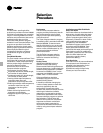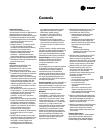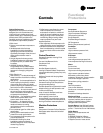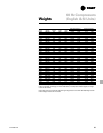
35
CTV-PRC007-EN
Controls
Optimal Performance
Regardless of the system level being
designed, the unit controls become
critical not just in making every level
operate reliably but in facilitating optimal
performance. UCP2 provides more
capability and more intelligence to make
this operation/ optimization possible:
Chiller Level
•
Factory mounted water temperature
sensors
•
Variable speed drive for those
installations in which the chiller is
operating at part load conditions a
significant percentage of the time and
where cold condenser water is
available.
•
Hot gas bypass for those process
installations where the chiller will need
to respond quickly to sudden load
increases.
•
ASHRAE Guideline 3 Report
incorporated into the Chiller Report
and Printer Report. Guideline 3 aids
operators in managing refrigerant
assets.
Chiller Plant Level
•
Heat recovery — to take advantage of
waste heat from the chiller for heating
applications.
•
Heat pump — for those applications in
which heating is the primary mission
of the chiller and cooling is a waste
product (requiring an endless source of
heat such as a well or lake water).
•
Free-cooling — for use in those parts of
the country where cold condenser
water is available to eliminate the need
to operate the compressor.
•
Variable flow — for applications where
either the condenser water or the
system water flows must vary.
•
Ice-making — for demand charge
avoidance or for additional capacity
needs and where no cooling
requirements exist for considerable
periods of time.
•
Low condenser gpm for chiller plant
optimization.
•
Cooling tower reset based on head
pressure for tower optimization.
•
Low evaporator fluid temperature for
process applications.
•
kW demand limiting for those
installations where avoidance of
demand charges is more critical than
maintaining capacity.
•
Chilled water reset (based on return
water temperatures or ambient
temperature or based on a 4-20 mA
signal) for those installations where
energy savings is more critical than
maintaining design leaving chilled
water temperature at part loads.
Applied Systems
•
Low evaporator fluid temperature for
cold air/humidity control applications.
•
Variable fluid flow where evaporator
flow is modulated by a device outside
the control of the chiller or the chiller
plant.
Control Functions
Constant Evaporator Leaving Fluid
Temperature
Current Limit/Demand Limit
Condenser Limit
Softloading
Hot Gas Bypass (optional)
Leaving Condenser Water Temperature
(programmable setting) heat pump only
(optional)
Ability to Control with Varying Water
Loop Flow
Heat Recovery Temperatures (optional)
Constant Entering Fluid Temperature
(programmable setting)
Variable Speed Drive (optional drive with
adaptive tuning for safe operation and
maximum efficiency)
Loss of Load for Sudden Load Loss
(nuisance trip prevention)
Note: capacity control can be
accomplished in several ways: entering
or leaving evaporator fluid temperature,
leaving condenser water temperature.
Machine Protections
Starter
Compressor Contactor Failure Detection
Solid-state starter heat sink (included
with SSS)
Compressor
Smart Shutdown Sequence
High Compressor Discharge
Temperature (optional)
Surge Detection
Extended Surge Protection
Oil Temperature
Bearing Temperatures (optional)
Condenser
Loss of flow
High condenser pressure limit
High pressure cutout
Evaporator
Loss of flow
Low refrigerant temperature limit
Low evaporator leaving fluid cutout
Motor
Current limit
Current overload
High motor winding temperatures
High vacuum operation lockout
Momentary power loss, phase
unbalance, phase loss, reverse rotation.
Over/under voltage is optional
Smart short cycling protection
Purge
Tank full protection
Low current detection
Continuous or excessive pumpout
detection
Excessive air leakage detection
Monitored Points
Chiller information is available at the
operator interface that can access a
variety of reports: Custom, Chiller
Refrigerant and Compressor.
Custom Report: User Defined Custom
Report (operator may choose up to 20
points — from a list of over 100 choices).
Chiller Report
Status, Fluid Temperatures and
Setpoints
•
ASHRAE Guideline 3 Report
•
Operating mode (i.e. run status)
•
Setpoint source or reset source
Functions/
Protections


















